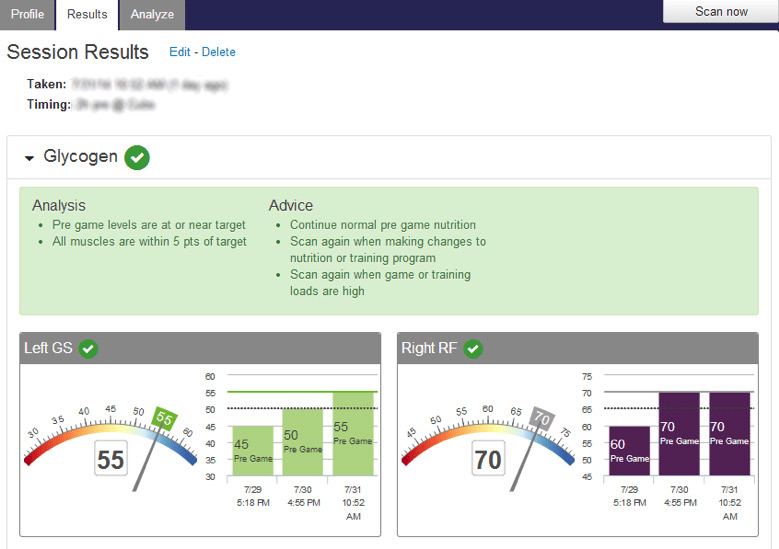High speed sprinting is a key feature of decisive game situations and during the most important games of the competitive season. In a study analyzing goal situations in professional soccer, 45% of all goals were preceded by a straight sprint from the scoring player1. In addition, elite Australian Rules football players double the number of maximum accelerations in finals compared to regular season games 2. Not surprisingly, in a time-motion study in basketball, researchers found that basketball requires a high frequency of linear sprints, short sprints, and repeat sprints. 3
It has been demonstrated in several studies that glycogen improves repeat sprint performance 4,5,6. However, what role does glycogen play during a single sprint? In a study of muscle metabolism during sprint running, glycogen contributed approximately 50% of the ATP within the muscle during a single 6-second sprint7. Combining this result with findings that muscle glycogen concentrations of lower than approximately 200 mmol/kg dry weight have been shown to significantly decrease the glycolytic rate 8,9and that glycogen can be significantly reduced following team games 10,11,12,13, resistance training14, and sports practice in basketball and football, it becomes clear that high muscle glycogen is desirable for athletes in team sports, such as soccer, rugby, Australian Rules football, American football, and basketball.

As mentioned above, the glycolytic rate is reduced when glycogen reaches a low value of 200 mmol/kg dry weight (approximately 30 MuscleSound score). In studies demonstrating improved intermittent sprint performance in high versus low glycogen groups, the high glycogen group typically has muscle glycogen concentrations of approximately 340 – 400 mmol/kg dry weight, which correspond to a MuscleSound glycogen score of approximately 60. In consideration of the above, it seems that athletes and their staff should work to achieve pre-training/competition MuscleSound scores of approximately 60, while trying to prevent scores from dropping beyond 40 by the end of the training/competition.
[1] Faude, O., T. Koch and T. Meyer (2012). Straight sprinting is the most frequent action in goal situations in professional football. J Sports Sci 30(7): 625-631
[2] Aughey RJ. Increased high-intensity activity in elite Australian football finals matches. Int J Sports Physiol Perform. 2011 Sep;6(3):367-79. PubMed PMID: 21911862.
[3] Conte D, Favero TG, Lupo C, Francioni FM, Capranica L, Tessitore A. Time-motion analysis of Italian elite women’s basketball games: individual and team analyses. J Strength Cond Res. 2014 Jul 21. [Epub ahead of print].
[4] Balsom PD, Wood K, Olsson P, Ekblom B: Carbohydrate intake and multiple sprint sports: with special reference to football (soccer). Int J Sports Med 1999; 20: 48-52.
[5] Akermark C, Jacobs I, Rasmusson M, Karlsson J: Diet and muscle glycogen concentration in relation to physical performance in Swedish elite ice hockey players. Int J Sport Nutr. 1996 Sep;6(3):272-84.
[6] Kein M, Duffield R, Kelly BT, Marino FE. The effects of carbohydrate intake and muscle glycogen content on self-paced intermittent-sprint exercise despite no knowledge of carbohydrate manipulation. Eur J Appl Physiol. 2012 Aug;112(8):2859-70. doi: 10.1007/s00421-011-2253-0. Epub 2011 Dec 3.
[7] Cheetham, M. E., L. Boobis, S. Brooks and C. Williams (1986). Human muscle metabolism during sprint running in man. Journal of Applied Physiology 61: 54-60.
[8] Bangsbo, J. (1994b). The physiology of soccer–with special reference to intense intermittent exercise. Acta Physiol Scand Suppl 619: 1-155.
[9] Phillips SM, Sproule J, Turner AP. Carbohydrate ingestion during team games exercise: current knowledge and areas for future investigation. Sports Med. 2011 Jul 1;41(7):559-85.
[10] Krustup P, Mohr M, Steensberg A, et al: Muscle and blood metabolites during a soccer game: implications for sprint performance. Med Sci Sports Exerc 2006; 38:1165-1174.
[11] Mohr M, Krustrup P, and Bangsbo J. Fatigue in soccer: a brief review. J Sports Sci. 2005; 23:593-599.
[12] Bangsbo J, Iaia FM, Krustrup P. Metabolic response and fatigue in soccer. Int J Sports Physiol Perform. 2007 Jun;2(2):111-27.
[13] Bendiksen M, Bischoff M, Randers MB, Mohr M, Rollo I, Suetta V, Bangsbo J, and Krustrup P. The Copenhagen Soccer Test: Physiological Response and Fatigue development. Med Sci Sports Exerc. 2012;44(8):1595–603.
[14] Camera DM, West DW, Burd NA, Phillips SM, Garnham AP, Hawley JA, Coffey VG. Low muscle glycogen concentration does not suppress the anabolic response to resistance exercise. J Appl Physiol (1985). 2012 Jul;113(2):206-14. doi:10.1152/japplphysiol.00395.2012. Epub 2012 May 24. PubMed PMID: 22628371.
